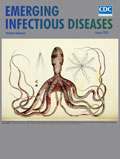
Volume 26, Number 8—August 2020
Research
Population Genomic Structure and Recent Evolution of Plasmodium knowlesi, Peninsular Malaysia
Abstract
Most malaria in Malaysia is caused by Plasmodium knowlesi parasites through zoonotic infection from macaque reservoir hosts. We obtained genome sequences from 28 clinical infections in Peninsular Malaysia to clarify the emerging parasite population structure and test for evidence of recent adaptation. The parasites all belonged to a major genetic population of P. knowlesi (cluster 3) with high genomewide divergence from populations occurring in Borneo (clusters 1 and 2). We also observed unexpected local genetic subdivision; most parasites belonged to 2 subpopulations sharing a high level of diversity except at particular genomic regions, the largest being a region of chromosome 12, which showed evidence of recent directional selection. Surprisingly, we observed a third subpopulation comprising P. knowlesi infections that were almost identical to each other throughout much of the genome, indicating separately maintained transmission and recent genetic isolation. Each subpopulation could evolve and present a broader health challenge in Asia.
All endemic human malaria parasite species originated as zoonotic crossover infections from nonhuman primates (1–3) and now cause approximately half a million human deaths annually (4). Until recently, zoonotic malaria was considered to be very rare, but original findings in Malaysia (5,6) and subsequent surveys elsewhere have revealed that many human malaria cases in Southeast Asia are caused by the macaque parasite Plasmodium knowlesi (7). This parasite species now causes almost all malaria in Malaysia (4) and is responsible for clinical cases throughout Southeast Asia, where the distributions of macaque reservoir hosts and mosquito vectors overlap with human populations (8). As several countries in Southeast Asia are working toward eliminating malaria, P. knowlesi represents a special public health challenge. Because of the presence of wild reservoir hosts, elimination of P. knowlesi is unlikely, and the problem will deepen if the parasite adapts or environments change to enable more effective transmission between humans (9). Of particular concern, numbers of cases each year are continuing to increase (4), and intensive surveillance in particular areas indicates this increase is not attributable to ascertainment bias (10).
Population genetic studies are essential to determining whether recent parasite adaptation has occurred, which might reflect ongoing evolution that is likely to affect the epidemiology. The P. knowlesi parasite has a ≈25 megabase genome of 14 chromosomes (11,12), haploid in blood stage infections and recombining in a brief diploid stage after male and female parasites mate in the mosquito vector, so informative studies require analysis of loci throughout the genome. Understanding of P. knowlesi population genetics has been gained by microsatellite genotyping (13,14) and whole-genome sequencing (15,16). In Malaysian Borneo, P. knowlesi consists of 2 genetically divergent populations (termed clusters 1 and 2) associated with different reservoir hosts: cluster 1 with long-tailed macaques (Macaca fascicularis) and cluster 2 with pig-tailed macaques (M. nemestrina) (14). In Peninsular Malaysia, on the mainland of Asia, a different genetic subpopulation of P. knowlesi exists. This subpopulation was initially indicated by comparing genome sequences of a few old laboratory isolates from Peninsular Malaysia with genome sequences of recent clinical samples from Borneo (15), and by comparing sequences of 2 genes in clinical samples from both areas (17). Subsequent multilocus microsatellite analysis of recent clinical cases of P. knowlesi infection from Peninsular Malaysia has confirmed that all cases are attributable to the cluster 3 type (13).
Experimental studies have been conducted on only a few strains of P. knowlesi, isolated many years ago and maintained in laboratory monkeys (18). Genome sequencing has revealed these strains to be of the cluster 3 type (13,15), and one of them has been adapted to in vitro culture in human erythrocytes, using 2 independent approaches involving culture with mixtures of macaque and human erythrocytes before growth in human erythrocytes alone (19,20). The short-term adaptability of this single strain is further illustrated by selection for culture in long-tailed macaque erythrocytes, which was associated with the loss of a specific ligand gene needed for invading human erythrocytes (21). These examples from laboratory observations strongly suggest that highly diverse natural parasite populations are likely to adapt to changing conditions.
All of the separately occurring P. knowlesi populations might evolve and emerge to present an even more serious public health challenge than already realized. To determine the population genetic substructure within P. knowlesi locally, we analyzed recent clinical samples from patients with P. knowlesi infection in Peninsular Malaysia by using whole-genome sequencing.






















.png)











No hay comentarios:
Publicar un comentario